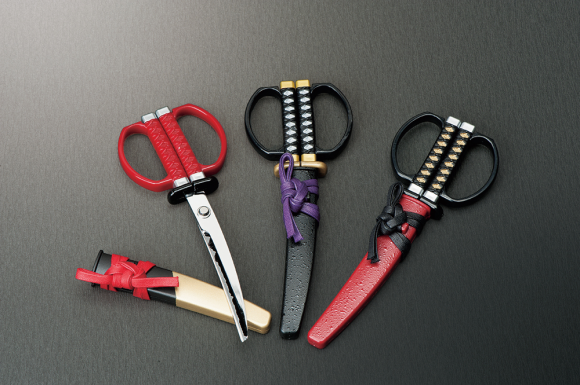
Merciless warlords and noble reformers serve as inspiration.
The town of Seki, in central Japan’s Gifu Prefecture, was once Japan’s most prestigious swordsmithing center. Actually, that’s an honor it can still claim today, but the sword industry isn’t exactly what it used to be, and so Seki’s craftsmen have diversified by taking the skills and pride passed on from their forbearers and using them to produce the kinds of blades for which demand stays steady even in our modern, non-feudal era.
And so Seki’s workshops now also churn out kitchen knives, shaving razors, and nail clippers. They also make scissors, and one company, Seki’s Nikken Cutlery, wants to combine its modern products with some of the town’s cultural heritage, which leads us to its line of Great Katana Scissors.
This isn’t Nikken’s first time to create practical-use edged instruments with samurai inspirations, but the new batch of four models is its most expansive yet. Three pairs of scissors are modeled after the personal katana of prominent daimyo warlords, starting with Oda Nobunaga’s Heshikiri Haseba, which he is said to have used to kill a servant who displeased him with a strike so heavy and violent that it was as much a crushing blow as a cutting slice.
Next is Date Masamune’s Shokudaikiri Mitsutada, said to have sliced through a bronze candleholder that the target of the northern warlord’s attack no doubt hoped would have been more effective at stopping what turned out to be a killing strike.
Mitsunokami Yoshiyuki, the sword of 19th-century samurai scholar and political reformer Sakamoto Ryoma, is an outlier in the group, seeing as how Ryoma lived some 200 years after the end of the Sengoku period that Nobunaga and Masamune were swinging their swords around in. Nevertheless, Ryoma remains one of the most widely respected and admired figures in Japanese history, and the scissors based on his sword carry the same quiet but firm dignity that Ryoma projects in his portraits.
The three above pairs of scissors are all identically priced at 3,800 yen (US$35), which includes their scabbards and display stands. For those desiring something even more stately, Nikken is also producing a limited batch of 100 paris of scissors based on Namazu Otoshiro, named for its resemblance to the curved, sinuous tail of a catfish.
The owner of Namazu Otoshiro was Tokugawa Ieyasu, whose eventual dominance over the other Sengoku period began the Tokugawa shogunate, which would go on to rule Japan for roughly three centuries during what came to be called the Edo period. The Namazu Otoshiro scissors’ handle and scabbard come treated in Echizen lacquer, applied by skilled artisans in Fukui Prefecture, and are priced at 15,000 yen, in accordance with their higher quality materials and exalted status.
Nikken is not selling the scissors through regular shops or online retailers, but instead as part of a crowdfunding campaign here on website Mirai Shopping. However, since the project has already exceeded its goal, and has 48 days left, pledging funds is now essentially the same as just buying them outright.
Source, images: @Press
[ Read in Japanese ]